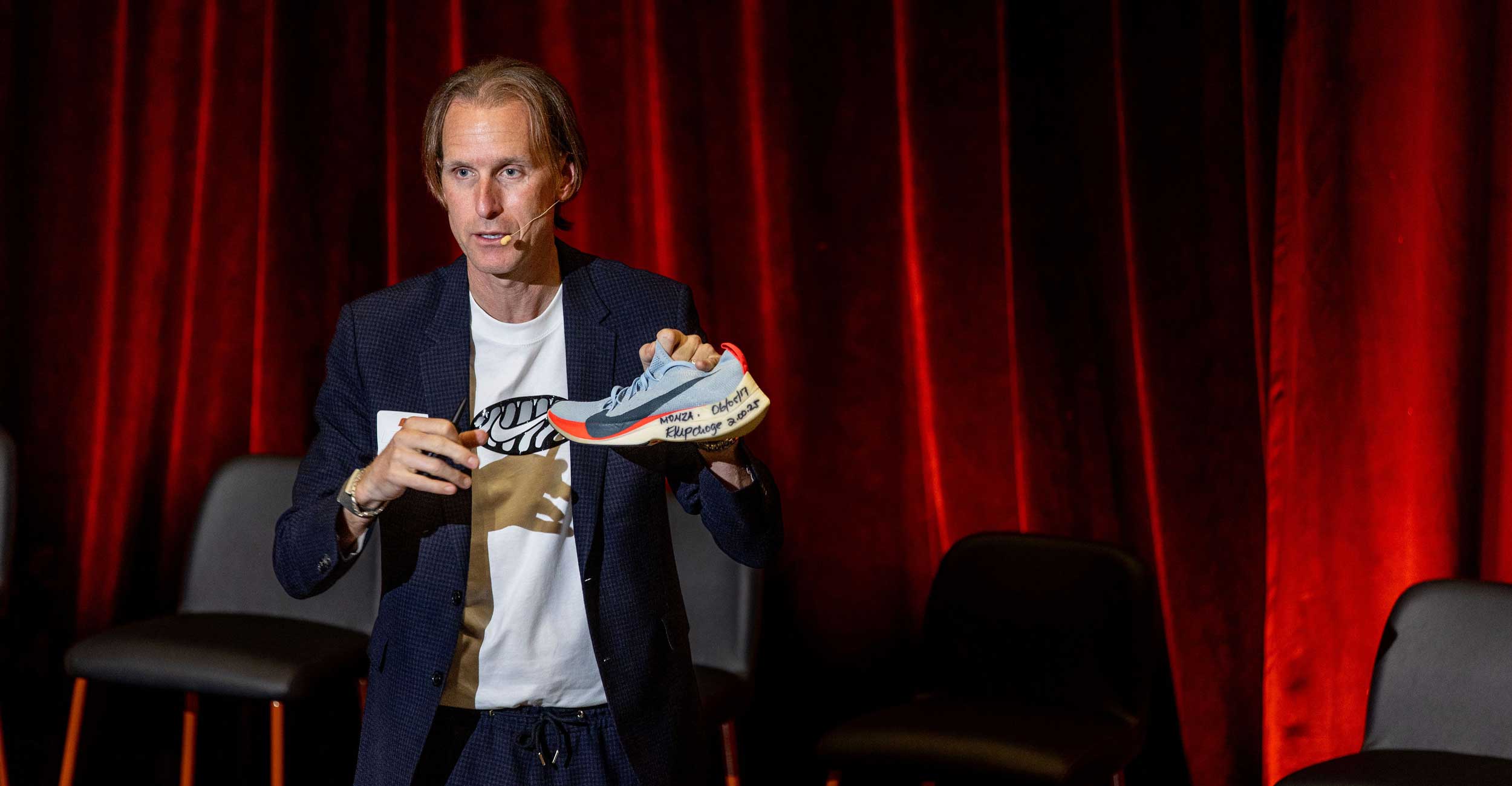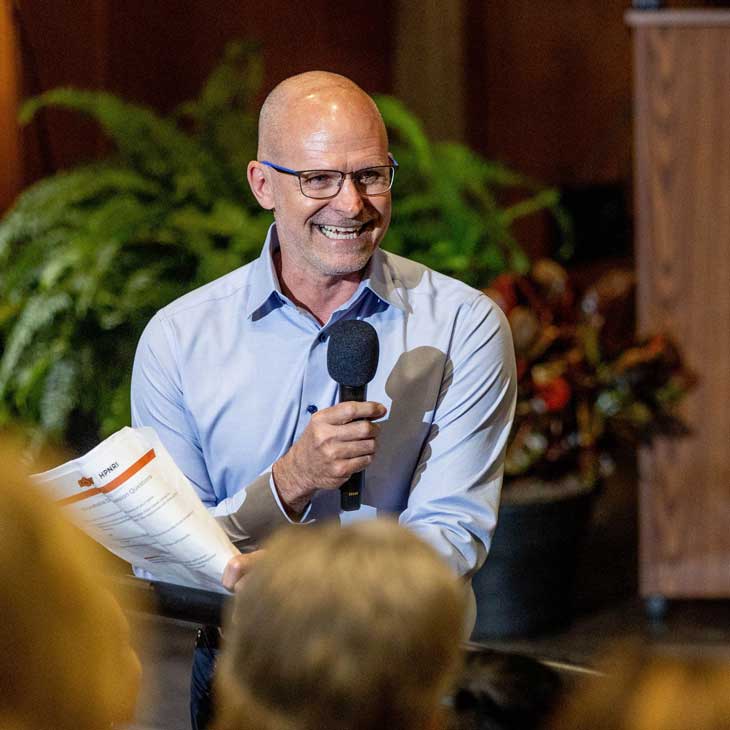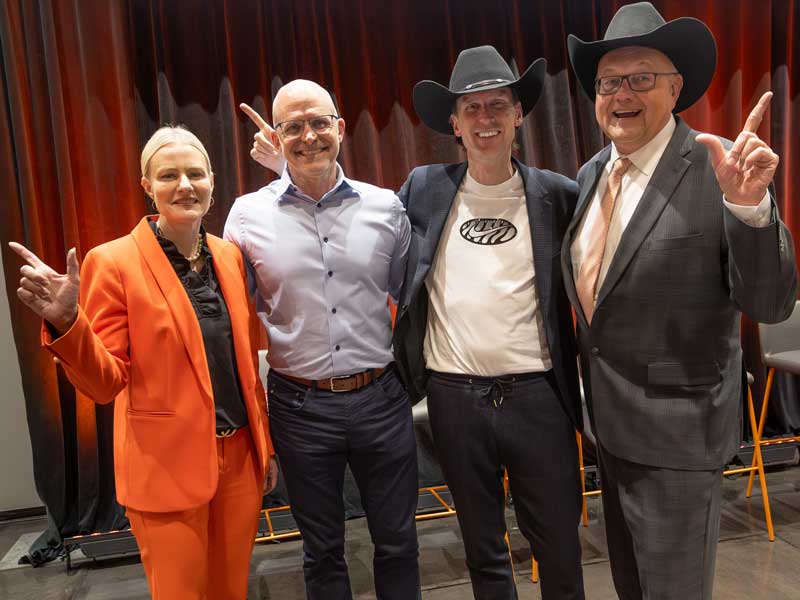
HPNRI Symposium showcases collaborative advancements in human performance, nutrition and health
Friday, April 19, 2024
Media Contact: Sydney Trainor | Communications and Media Relations Specialist | 405-744-9782 | sydney.trainor@okstate.edu
Thought leaders from across the OSU System came together Thursday to connect and explore new opportunities to advance healthy lifestyles in Oklahoma.
The second annual Human Performance and Nutrition Research Institute Symposium showcased HPNRI's transdisciplinary efforts across the broader OSU System and offered insightful perspectives from guests on the game-changing potential of a performance-based approach to health and wellness.

“Today is about bringing us all together,” said Lance Walker, the Rick and Gail Muncrief executive director of HPNRI. “We did this a year ago, when we brought the campus together to create collision. We're going to do it again this year. Now, we have brought in another element to this. We brought in partners who we can begin working with as we begin to expand some of our collaborations here on campus.”
The Nike philosophy
Tony Bignell, vice president of Nike Men’s Performance Footwear, delivered a keynote address about innovation at Nike through four principles.
“We aligned behind these four guiding principles: Listen to the voice of the athletes; dream big, dream audaciously; players and team respect each other and work hard; and then fail forward fast,” Bignell said.
Eliud Kipchoge, a Kenyan marathon runner, dreamed big when Nike set out to help him run a marathon in less than two hours.
“Eliud wanted to be the first person ever to run under two hours for the marathon,” Bignell said. “At the point we started, the world record was 2:03. OK, how do you get rid of three minutes? Well, three minutes is like a kilometer. It's not like you're going to break the record by this much. It's really impossible.”
Nike began innovating to design shoes that would help accomplish the goal.
“It's all about people,” Bignell said. “It's all about coming together behind a singular vision, working hard, checking your egos at the door and all of those things.”
Bignell said they started with science to reduce the weight of a shoe, while stiffening the front and minimizing leg impact to increase speed. Then, they listened to their athletes who wanted a shoe that didn’t make their calves hurt after running 20 miles the previous day.
Not only was Nike on a mission to create a shoe that propelled Kipchoge to break the barrier in 2019, but then they met another challenge forcing them to fail forward.
“Once you've made one pair and you've done the race then — we like to make shoes and sell shoes that's kind of what we do — you have to figure out how do you go from making one to make millions,” Bignell said. “That's often harder."
While Nike works with athletes to make clothes and shoes, Bignell said the principles of life are transferable to a personal level and to institutions like HPNRI.
"If you listen well, if you focus, you have to follow your dreams, if you're not afraid to fail, and if you put the team above yourself, normally good things happen,” he said.
Better health through Extension
Dr. Roger Rennekamp, Association of Public and Land-Grant Universities extension health director, also delivered a keynote address on the DNA and ethos of a land-grant institution, emphasizing that their essence is ingrained in their DNA and reflected in their infrastructure.
With a career immersed in Extension, Rennekamp has focused on health equity and community empowerment. In his role, he leads initiatives aimed at harnessing the collective power of the nation's 111 land-grant universities to prioritize human health and well-being through community engagement.
Cooperative Extension’s extensive network across the country traditionally focused on agriculture but has since broadened its scope to encompass a health framework. Similarly, the OSU System has mirrored that vision through HPNRI and OSU Extension.
“Generally, a lot of people would agree 30% of our health is determined by roughly our behaviors, the things that we do and how that we spend our time but the remaining 70% comes from clinical care, the physical environment we live in and the socioeconomic factors,” Rennekamp said.
As the symposium continued, the threads of innovation were woven through Extension, One Health, performance, technology and research during panel discussions and presentations.
Some key collaborations involve OSU Extension, the College of Education and Human Sciences, and OSU Agriculture through partnerships to improve human health and nutrition.
With 15 years in education, CEHS Dean Jon Pedersen has learned the principle of collaborative teamwork across boundaries is vital for transforming lives and enhancing the human condition.
“We can't do it alone,” Dr. Pedersen said. "When you think about kids in schools and you think about their achievement, only 25-30% of achievement can be attributed to in class experiences, which means a whole lot goes outside those four walls.”
OSU First Cowboy Darren Shrum shared how he helped the university dream big by taking a step toward feeding a growing population through the Student Farm, where students engage in experiential learning to supply fresh produce to underserved communities, distributing over 53,000 pounds to the community in its inaugural season.
Expanding health outreach
During another panel session, HPNRI shared its collaboration with OSU Center for Health Sciences and OSU Extension to expand Project ECHO through new ECHO lines: Athletic Training - Sports Medicine, Pediatric Obesity and Building Healthy School Communities.
Seventy percent of counties in Oklahoma do not have access to any kind of athletic health care for their student athletes, said Dr. Aric Warren, OSU-CHS athletic training professor and ECHO hub team lead.
In its inaugural year, the sports medicine ECHO has reached over 400 attendees, providing information to 40 K-12 schools, 30 higher education institutions, across 44 counties in Oklahoma, 18 states, and two countries.
The Building Healthy School Communities pilot project, launched in January, assesses the physical and health literacy needs of participating school districts and identifies ways HPNRI can support them through partnerships or collaborations.
“Recent research tells us that nutrition, physical activity and healthy relationships play a part not only in academic success, but also in our students' mental health,” said Shana Classen, Oklahoma State Department of Education director of health and physical education. "That's something we've heard over and over from not only our students and our teachers, that it’s something that we're really needing to focus on.”
HPNRI’s collaborative efforts continued to be showcased through sports medicine innovation and athletic training technology with OSU Athletics.
Dr. Jason Moore shared how the integration with OSU-CHS and OSU Medicine has looked like with OSU athletics. The integration meant bringing expertise from Tulsa to Stillwater through the addition of athletic training, behavioral health and physician positions to impact athletic performance.

“When you bring in an institution that has so much experience in delivering medical care, that just adds to the ability to provide that care to the population and brings insight that may help athletics,” Moore said.
The symposium not only emphasized research and collaboration within traditional athletes but also addressed the needs of tactical athletes such as law enforcement, fire, and military personnel through the Tactical Fitness and Nutrition Lab.
The focus is on health, fitness and performance to ensure those athletes can effectively carry out their physically demanding tasks and maintain public safety and national security. Through collaboration and research, the team aims to provide tailored support and resources to improve athletes' capabilities and overall performance, said Dr. Jay Dawes, associate professor of applied exercise science.
Dr. Jai Rajendran, OSU Office of Technology Commercialization technology and business development manager, and Dr. Jill Joyce, associate professor of public health nutrition, shared how they use The Innovation Foundation at OSU’s App Center to develop mobile apps that improve human health and performance.
Rajendran was driven to understand cardiometabolic disease due to a family experience. He set out to collaborate with other disciplinary researchers and develop a critical application called BaseMetrics to help in primary and secondary prevention of cardiovascular disease.
Joyce saw a need and developed an app that integrates with popular fitness apps, utilizing the Healthy Eating index scoring system to offer clear guidance on nutritional choices. Users can easily prioritize areas for improvement and receive personalized tips. The app even allows for tracking progress over time and provides suggestions for further enhancements.
"The HPNRI Symposium witnessed the convergence of scholarly inquiry and scientific progress,” said Elizabeth Pollard, CEO of The Innovation Foundation. “Through this symposium, innovation and dedication converge to shape a future where the health of Oklahomans flourishes. Together, as we exchange insights and drive applied research, we pave the way for a healthier tomorrow, empowering individuals and communities to thrive."
